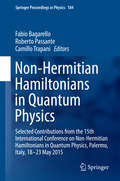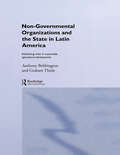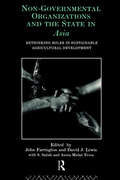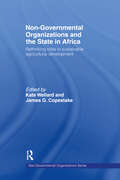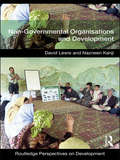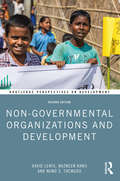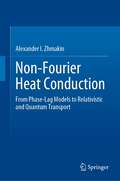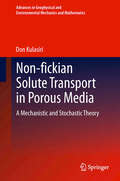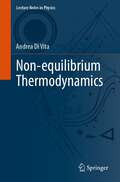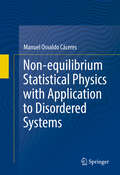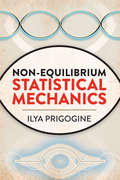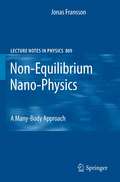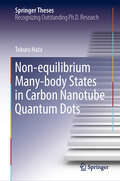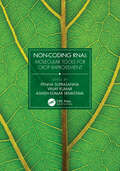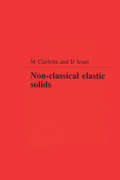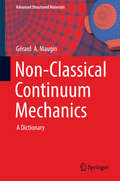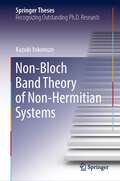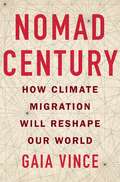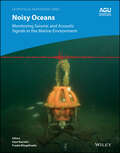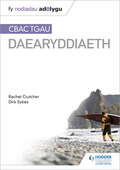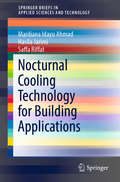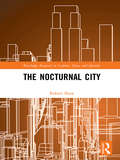- Table View
- List View
Non-Hermitian Hamiltonians in Quantum Physics
by Fabio Bagarello Roberto Passante Camillo TrapaniThis book presents the Proceedings of the 15th International Conference on Non-Hermitian Hamiltonians in Quantum Physics, held in Palermo, Italy, from 18 to 23 May 2015. Non-Hermitian operators, and non-Hermitian Hamiltonians in particular, have recently received considerable attention from both the mathematics and physics communities. There has been a growing interest in non-Hermitian Hamiltonians in quantum physics since the discovery that PT-symmetric Hamiltonians can have a real spectrum and thus a physical relevance. The main subjects considered in this book include: PT-symmetry in quantum physics, PT-optics, Spectral singularities and spectral techniques, Indefinite-metric theories, Open quantum systems, Krein space methods, and Biorthogonal systems and applications. The book also provides a summary of recent advances in pseudo-Hermitian Hamiltonians and PT-symmetric Hamiltonians, as well as their applications in quantum physics and in the theory of open quantum systems.
Non-Governmental Organizations and the State in Latin America: Rethinking Roles in Sustainable Agricultural Development
by Anthony Bebbington, Graham Thiele, Penelope Davies, Martin Prager, Hernando RiverosThis presents twenty specially commissioned case studies of farmer participatory approaches to agricultural innovation initiated by NGOs in Latin America. Beginning with a broad review of institutional activity at the grassroots, the authors set the case material within the context of NGO relations with the State and their contribution to democratisation and the consolidation of rural civil society. Specific questions are raised: how good/bad are NGOs at promoting technological innovation and addressing constraints to change in present agriculture?; how effective are NGOs at strengthening grassroots organizations? and how do/will donor pressures influence NGOs and their links to the State? This title is part of a series on Non-Governmental Organizations co-ordinated by the Overseas Development Institute. To complete this comprehensive review and critique there are two other regional case study volumes on Asia and Africa and an overview volume, Reluctant Partners?
Non-Governmental Organizations and the State in Asia: Rethinking Roles in Sustainable Agricultural Development (Non-Governmental Organizations series)
by John Farrington David J. Lewis S. Satish Aurea Miclat-TevesFirst published in 1993. Routledge is an imprint of Taylor & Francis, an informa company.
Non-Governmental Organizations and the State in Africa: Rethinking Roles in Sustainable Agricultural Development (Non-governmental Organizations Ser.)
by Kate Wellard James G. CopestakeThis presents twenty specially commissioned case studies of farmer participatory approaches to agricultural innovation initiated by NGOs in Africa. Beginning with a broad review of institutional activity at the grassroots, the authors set the case material within the context of NGO relations with the State and their contribution to democratisation and the consolidation of rural civil society. Specific questions are raised: how good/bad are NGOs at promoting technological innovation and addressing constraints to change in present agriculture?; how effective are NGOs at strengthening grassroots organizations? and how do/will donor pressures influence NGOs and their links to the State? This title is part of a series on Non-Governmental Organizations co-ordinated by the Overseas Development Institute. To complete this comprehensive review and critique there are two other regional case study volumes on Asia and Latin America and an overview volume, Reluctant Partners?
Non-Governmental Organizations and Development
by David Lewis Nazneen KanjiNon-governmental organizations (NGOs) are high profile actors in the field of international development, both as providers of services to vulnerable individuals and communities and as campaigning policy advocates. This book provides a critical introduction to the wide-ranging topic of NGOs and development. Written by two authors with more than twenty years experience of research and practice in the field, the book combines a critical overview of the main research literature with a set of up-to-date theoretical and practical insights drawn from experience in Asia, Europe, Africa and elsewhere. It highlights the importance of NGOs in development, but it also engages fully with the criticisms that the increased profile of NGOs in development now attracts. Non-Governmental Organizations and Development begins with a discussion of the wide diversity of NGOs and their roles, and locates their recent rise to prominence within broader histories of struggle as well as within the ideological context of neo-liberalism. It then moves on to analyze how interest in NGOs has both reflected and informed wider theoretical trends and debates within development studies, before analyzing NGOs and their practices, using a broad range of short case studies of successful and unsuccessful interventions. David Lewis and Nazneen Kanji then moves on to describe the ways in which NGOs are increasingly important in relation to ideas and debates about ‘civil society’, globalization and the changing ideas and practices of international aid. The book argues that NGOs are now central to development theory and practice and are likely to remain important actors in development in the years to come. In order to appreciate the issues raised by their increasing diversity and complexity, the authors conclude that it is necessary to deploy a historically and theoretically informed perspective. This critical overview will be useful to students of development studies at undergraduate and masters levels, as well as to more general readers and practitioners. The format of the book includes figures, photographs and case studies as well as reader material in the form of summary points and questions. Despite the growing importance of the topic, no single short, up-to-date book exists that sets out the main issues in the form of a clearly written, academically-informed text: until now.
Non-Governmental Organizations and Development (Routledge Perspectives on Development)
by David Lewis Nazneen Kanji Nuno S. ThemudoThis book is an introduction to the wide-ranging topic of non-governmental organizations (NGOs) and development, combining a critical overview of the main research literature with a set of up-to-date theoretical and practical insights drawn from experience in Asia, Europe, Africa and elsewhere. The revised second edition highlights the continuing importance of NGOs in development, while fully engaging with the criticisms that their increased profile now attracts. It considers issues such as securitization, changing technologies, and recent concerns about safeguarding as well as going into more detail around topics such as market-based development and social enterprise. The diversity of NGOs and their roles is discussed against the broader historical background of struggles for social justice in different societies, as well as within the shifting ideological contexts of neoliberalism and populism. Using a broad range of short case studies of both successful and unsuccessful interventions, the authors analyze how interest in NGOs has both reflected and informed wider theoretical trends and debates within development studies. The book argues that NGOs are central to both development theory and practice and are likely to remain important actors for many years to come. This critical overview will be useful to students of development studies at undergraduate and master's levels in fields and disciplines as diverse as International Development Studies, International Relations, Geography, Anthropology, Global Studies, Politics and International Studies, as well as general readers and practitioners.
Non-Fourier Heat Conduction: From Phase-Lag Models to Relativistic and Quantum Transport
by Alexander I. ZhmakinThis book presents a broad and well-structured overview of various non-Fourier heat conduction models. The classical Fourier heat conduction model is valid for most macroscopic problems. However, it fails when the wave nature of the heat propagation becomes dominant and memory or non-local spatial effects become significant; e.g., during ultrafast heating, heat transfer at the nanoscale, in granular and porous materials, at extremely high values of the heat flux, or in heat transfer in biological tissues. The book looks at numerous non-Fourier heat conduction models that incorporate time non-locality for materials with memory, such as hereditary materials, including fractional hereditary materials, and/or spatial non-locality, i.e. materials with a non-homogeneous inner structure. Beginning with an introduction to classical transport theory, including phase-lag, phonon, and thermomass models, the book then looks at various aspects of relativistic and quantum transport, including approaches based on the Landauer formalism as well as the Green-Kubo theory of linear response. Featuring an appendix that provides an introduction to methods in fractional calculus, this book is a valuable resource for any researcher interested in theoretical and numerical aspects of complex, non-trivial heat conduction problems.
Non-fickian Solute Transport in Porous Media
by Don KulasiriThe advection-dispersion equation that is used to model the solute transport in a porous medium is based on the premise that the fluctuating components of the flow velocity, hence the fluxes, due to a porous matrix can be assumed to obey a relationship similar to Fick's law. This introduces phenomenological coefficients which are dependent on the scale of the experiments. This book presents an approach, based on sound theories of stochastic calculus and differential equations, which removes this basic premise. This leads to a multiscale theory with scale independent coefficients. This book illustrates this outcome with available data at different scales, from experimental laboratory scales to regional scales.
Non-fickian Solute Transport in Porous Media: A Mechanistic and Stochastic Theory (Advances in Geophysical and Environmental Mechanics and Mathematics)
by Don KulasiriThe advection-dispersion equation that is used to model the solute transport in a porous medium is based on the premise that the fluctuating components of the flow velocity, hence the fluxes, due to a porous matrix can be assumed to obey a relationship similar to Fick’s law. This introduces phenomenological coefficients which are dependent on the scale of the experiments. This book presents an approach, based on sound theories of stochastic calculus and differential equations, which removes this basic premise. This leads to a multiscale theory with scale independent coefficients. This book illustrates this outcome with available data at different scales, from experimental laboratory scales to regional scales.
Non-equilibrium Thermodynamics (Lecture Notes in Physics #1007)
by Andrea Di VitaThe importance of thermodynamics, particularly its Second Principle, to all branches of science in which systems with very large numbers of particles are involved cannot be overstated. This book offers a panoramic view of non-equilibrium thermodynamics. Perhaps the two most attractive aspects of thermodynamic equilibrium are its stability and its independence from the specifics of the particular system involved. Does an equivalent exist for non-equilibrium thermodynamics? Many researchers have tried to describe such stability in the same way that the Second Principle describes the stability of thermodynamic equilibrium - and failed. Most of them invoked either entropy, or its production rate, or some modified version of it. In their efforts, however, those researchers have found a lot of useful stability criteria for far-from-equilibrium states. These criteria usually take the form of variational principles, in terms of the minimization or maximization of some quantity. The aim of this book is to discuss these variational principles by highlighting the role of macroscopic quantities. This book is aimed at a wider audience than those most often exposed to the criteria described, i.e., undergraduates in STEM, as well as the usual interested and invested professionals.
Non-equilibrium Statistical Physics with Application to Disordered Systems
by Manuel Osvaldo CáceresThis textbook is the result of the enhancement of several courses on non-equilibrium statistics, stochastic processes, stochastic differential equations, anomalous diffusion and disorder. The target audience includes students of physics, mathematics, biology, chemistry, and engineering at undergraduate and graduate level with a grasp of the basic elements of mathematics and physics of the fourth year of a typical undergraduate course. The little-known physical and mathematical concepts are described in sections and specific exercises throughout the text, as well as in appendices. Physical-mathematical motivation is the main driving force for the development of this text. It presents the academic topics of probability theory and stochastic processes as well as new educational aspects in the presentation of non-equilibrium statistical theory and stochastic differential equations.. In particular it discusses the problem of irreversibility in that context and the dynamics of Fokker-Planck. An introduction on fluctuations around metastable and unstable points are given. It also describes relaxation theory of non-stationary Markov periodic in time systems. The theory of finite and infinite transport in disordered networks, with a discussion of the issue of anomalous diffusion is introduced. Further, it provides the basis for establishing the relationship between quantum aspects of the theory of linear response and the calculation of diffusion coefficients in amorphous systems.
Non-Equilibrium Statistical Mechanics (Dover Books On Physics Series)
by Ilya PrigogineIlya Prigogine won the 1977 Nobel Prize in Chemistry for his contributions to non-equilibrium thermodynamics. This groundbreaking 1962 monograph, written for researchers and graduate students in this field, was his first book-length contribution to this subject. Suitable for advanced undergraduates and graduate students in physics and chemistry, the treatment begins with examinations of the Liouville equation, anharmonic solids, and Brownian motion. Subsequent chapters explore weakly coupled gases, scattering theory and short-range forces, distribution functions and their diagrammatic representation, the time dependence of diagrams, the approach to equilibrium in ionized gases, and statistical hydrodynamics. Additional topics include general kinetic equations, general H-theorem, quantum mechanics, and irreversibility and invariants of motion. Appendices, a bibliography, list of symbols, and an index conclude the text.
Non-Equilibrium Nano-Physics: A Many-Body Approach
by Jonas FranssonThe aim of this book is to present a formulation of the non-equilibrium physics in nanoscale systems in terms of many-body states and operators and, in addition, discuss a diagrammatic approach to Green functions expressed by many-body states. The intention is not to give an account of strongly correlated systems as such. Thus, the focus of this book ensues from the typical questions that arise when addressing nanoscale systems from a practical point of view, e.g. current-voltage asymmetries, negative differential conductance, spin-dependent tunneling. The focus is on nanoscale systems constituted of complexes of subsystems interacting with one another, under non-equilibrium conditions, in which the local properties of the subsystems are preferably being described in terms of its (many-body) eigenstates.
Non-equilibrium Many-body States in Carbon Nanotube Quantum Dots (Springer Theses)
by Tokuro HataThis book presents the first experiment revealing several unexplored non-equilibrium properties of quantum many-body states, and addresses the interplay between the Kondo effect and superconductivity by probing shot noise. In addition, it describes in detail nano-fabrication techniques for carbon nanotube quantum dots, and a measurement protocol and principle that probes both equilibrium and non-equilibrium quantum states of electrons. The book offers various reviews of topics in mesoscopic systems: shot noise measurement, carbon nanotube quantum dots, the Kondo effect in quantum dots, and quantum dots with superconducting leads, which are relevant to probing non-equilibrium physics. These reviews offer particularly valuable resources for readers interested in non-equilibrium physics in mesoscopic systems. Further, the cutting-edge experimental results presented will allow reader to catch up on a vital new trend in the field.
Non-Coding RNAs: Molecular Tools for Crop Improvement
by Penna Suprasanna Vinay Kumar Ashish Kumar SrivastavaThis reference book compiles updated research on non-coding RNAs and their role in producing high-yielding plants with higher productivity under changing climates. Plant non-coding RNAs are emerging as the key regulators of plant responses to climate change and environmental stresses. The book covers the sequencing, identification, prediction, identification, characterization, and targets of non-coding RNAs to engineer high-yielding crops. It also includes in silico tools and databases to study them. Key features: Discusses the different types of non-coding RNAs including lnc-RNAs, siRNA, microRNAs, and tasiRNAs. Covers the role of plant non-coding RNAs in epigenetic regulation of environmental stress response and tolerance. Reviews the role of non-coding RNAs under environmental stresses like drought, water logging, salinity, extreme temperature, UV, heavy metals, and xenobiotics. Explores the use of non-coding RNAs in transgenic crops and genome editing. Describes the biogenesis, history, and classification of non-coding RNAs in plants. The book provides a mix of basic and advanced information for postgraduate students, researchers, and scientists in the fields of plant molecular biology, biotechnology, food security, and agriculture.
Non-Classical Elastic Solids
by Michele Ciarletta D. IesanProblems concerning non-classical elastic solids continue to attract the attention of mathematicians, scientists and engineers. Research in this area addresses problems concerning many substances, such as crystals, polymers, composites, ceramics and blood. This comprehensive, accessible work brings together recent research in this field, and will be of great interest to mathematicians, physicists and other specialists working in this area.
Non-Classical Continuum Mechanics: A Dictionary (Advanced Structured Materials #51)
by Gérard A. MauginThis dictionary offers clear and reliable explanations of over 100 keywords covering the entire field of non-classical continuum mechanics and generalized mechanics, including the theory of elasticity, heat conduction, thermodynamic and electromagnetic continua, as well as applied mathematics. Every entry includes the historical background and the underlying theory, basic equations and typical applications. The reference list for each entry provides a link to the original articles and the most important in-depth theoretical works. Last but not least, every entry is followed by a cross-reference to other related subject entries in the dictionary.
Non-Bloch Band Theory of Non-Hermitian Systems (Springer Theses)
by Kazuki YokomizoThis book constructs a non-Bloch band theory and studies physics described by non-Hermitian Hamiltonian in terms of the theory proposed here.In non-Hermitian crystals, the author introduces the non-Bloch band theory which produces an energy spectrum in the limit of a large system size. The energy spectrum is then calculated from a generalized Brillouin zone for a complex Bloch wave number. While a generalized Brillouin zone becomes a unit circle on a complex plane in Hermitian systems, it becomes a circle with cusps in non-Hermitian systems. Such unique features of the generalized Brillouin zone realize remarkable phenomena peculiar in non-Hermitian systems. Further the author reveals rich aspects of non-Hermitian physics in terms of the non-Bloch band theory. First, a topological invariant defined by a generalized Brillouin zone implies the appearance of topological edge states. Second, a topological semimetal phase with exceptional points appears, The topological semimetal phase is unique to non-Hermitian systems because it is caused by the deformation of the generalized Brillouin zone by changes of system parameters. Third, the author reveals a certain relationship between the non-Bloch waves and non-Hermitian topology.
Nomad Century: How Climate Migration Will Reshape Our World
by Gaia Vince“The MOST IMPORTANT BOOK I imagine I'll ever read.”—Mary RoachFROM AN AWARD-WINNING SCIENCE JOURNALIST comes an urgent investigation of environmental migration—the most underreported, seismic consequence of our climate crisis that will force us to change where—and how—we live.“An IMPORTANT and PROVOCATIVE start to a crucial conversation.” —Bill McKibben“We are facing a species emergency. We can survive, but to do so will require a planned and deliberate migration of a kind humanity has never before undertaken. This is the biggest human crisis you’ve never heard of.”Drought-hit regions bleeding those for whom a rural life has become untenable. Coastlines diminishing year on year. Wildfires and hurricanes leaving widening swaths of destruction. The culprit, most of us accept, is climate change, but not enough of us are confronting one of its biggest, and most present, consequences: a total reshaping of the earth’s human geography. As Gaia Vince points out early in Nomad Century, global migration has doubled in the past decade, on track to see literal billions displaced in the coming decades. What exactly is happening, Vince asks? And how will this new great migration reshape us all?In this deeply-reported clarion call, Vince draws on a career of environmental reporting and over two years of travel to the front lines of climate migration across the globe, to tell us how the changes already in play will transform our food, our cities, our politics, and much more. Her findings are answers we all need, now more than ever.
Noisy Oceans: Monitoring Seismic and Acoustic Signals in the Marine Environment (Geophysical Monograph Series #284)
by Gaye Bayrakci Frauke KlingelhoeferNoisy Oceans Measuring devices such as ocean bottom seismometers and hydrophones designed to detect earthquakes pick up many other signals. These were previously ignored as background noise from unknown sources, but advanced technology now allows insights into the noise created from icebergs, ships, hydrothermal vents, whales, rain, marine engineering, and more. Noisy Oceans: Monitoring Seismic and Acoustic Signals in the Marine Environment is a comprehensive guide to non-tectonic marine noise originating from different environmental, biological, and anthropogenic sources. Volume highlights include: Overview of marine soundscapes and their sources Existing and new methods for studying acoustic signals Case studies from around the world Spans disciplines from geology and geophysicists to biology Explores the impacts and implications of marine noise The American Geophysical Union promotes discovery in Earth and space science for the benefit of humanity. Its publications disseminate scientific knowledge and provide resources for researchers, students, and professionals.
Noise Sensitivity of Boolean Functions and Percolation
by Christophe Garban Jeffrey E. SteifThis is a graduate-level introduction to the theory of Boolean functions, an exciting area lying on the border of probability theory, discrete mathematics, analysis, and theoretical computer science. Certain functions are highly sensitive to noise; this can be seen via Fourier analysis on the hypercube. The key model analyzed in depth is critical percolation on the hexagonal lattice. For this model, the critical exponents, previously determined using the now-famous Schramm–Loewner evolution, appear here in the study of sensitivity behavior. Even for this relatively simple model, beyond the Fourier-analytic set-up, there are three crucially important but distinct approaches: hypercontractivity of operators, connections to randomized algorithms, and viewing the spectrum as a random Cantor set. This book assumes a basic background in probability theory and integration theory. Each chapter ends with exercises, some straightforward, some challenging.
Nodiadau Adolygu (My Revision Notes: Cbac Tgau Daearyddiaeth (my Revision Notes: Wjec Gcs
by Dirk Sykes Rachel CrutcherExam Board: WJECLevel: GCSESubject: GeographyFirst teaching: September 2016First exams: Summer 2018Target success in WJEC GCSE Geography with this proven formula for effective, structured revision. Key content coverage is combined with exam-style tasks and practical tips to create a revision guide that students can rely on to review, strengthen and test their knowledge.With My Revision Notes every student can:- Plan and manage a successful revision programme using the topic-by-topic planner- Enjoy an active approach to revision with clear topic coverage and related 'Now Test Yourself' tasks and practical revision activities- Improve exam technique through exam tips and formal exam-style questions- Monitor their knowledge and progress using the answers provided for each 'Now Test Yourself' activity and exam-style question- Develop geographical understanding and enhance exam responses with event/place examplesPlease note: This is a Welsh-language edition.
Nodiadau Adolygu: CBAC TGAU Daearyddiaeth (My Revision Notes: WJEC GCSE Geography Welsh-language edition)
by Dirk Sykes Rachel CrutcherExam Board: WJECLevel: GCSESubject: GeographyFirst teaching: September 2016First exams: Summer 2018Target success in WJEC GCSE Geography with this proven formula for effective, structured revision. Key content coverage is combined with exam-style tasks and practical tips to create a revision guide that students can rely on to review, strengthen and test their knowledge.With My Revision Notes every student can:- Plan and manage a successful revision programme using the topic-by-topic planner- Enjoy an active approach to revision with clear topic coverage and related 'Now Test Yourself' tasks and practical revision activities- Improve exam technique through exam tips and formal exam-style questions- Monitor their knowledge and progress using the answers provided for each 'Now Test Yourself' activity and exam-style question- Develop geographical understanding and enhance exam responses with event/place examplesPlease note: This is a Welsh-language edition.
Nocturnal Cooling Technology for Building Applications (SpringerBriefs in Applied Sciences and Technology)
by Mardiana Idayu Ahmad Hasila Jarimi Saffa RiffatThis book discusses nocturnal cooling technologies for building applications. Exploiting the natural environment as a renewable and sustainable resource has become a significant strategy for passive energy saving in buildings, and has led to growing interest in the use of passive radiative cooling based on nighttime (nocturnal) and daytime (diurnal) operating periods. Of these, nocturnal cooling is more promising since diurnal cooling is hard to achieve due to the solar radiation effect. As such, this book provides a comprehensive overview of nocturnal cooling for building applications, including a definition, concepts and principles; materials and devices; and cooling systems and configurations.
The Nocturnal City (Routledge Research in Culture, Space and Identity)
by Robert ShawNight is a foundational element of human and animal life on earth, but its interaction with the social world has undergone significant transformations during the era of globalization. As the economic activity of the ‘daytime’ city has advanced into the night, other uses of the night as a time for play, for sleep or for escaping oppression have come increasingly under threat. This book looks at the relationship between night and society in contemporary cities. It identifies that while theories of ‘planetary urbanization’ have traced the spatial spread of urban forms, the temporal expansion of urban capitalism has been less well mapped. It argues that, as a key part of planetary being, understanding what goes on at night in cities can add nuance to debates on planetary urbanization. A series of practices and spaces that we encounter in the night-time city are explored. These include: the maintenance and repair of infrastructure; the aesthetics of the urban night; nightlife and the night-time economy; the home at night; and the ecologies of the urban night. Taking these forward the book will ask whether the night can reveal some of the boundaries to what we call ‘the urban’ in a world of cities, and will call for a revitalized and enhanced ‘nightology’ to study these limits.
